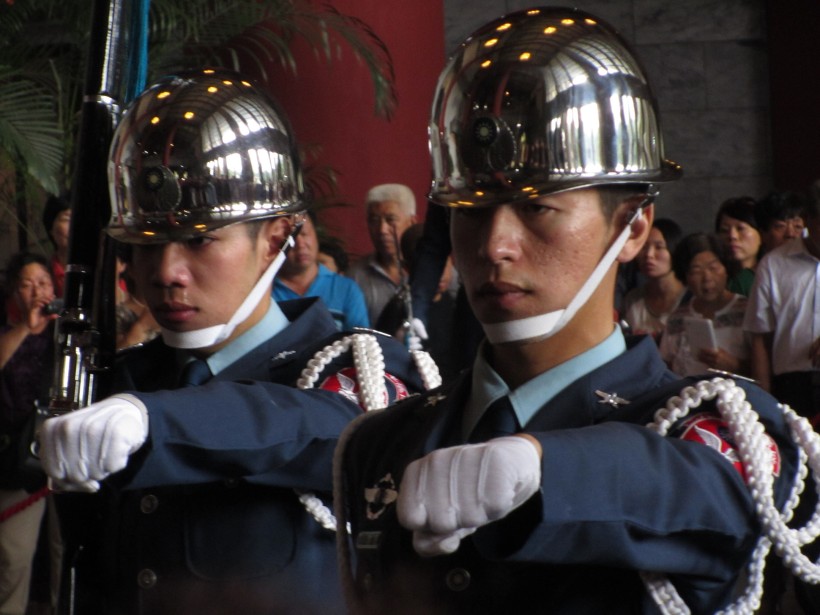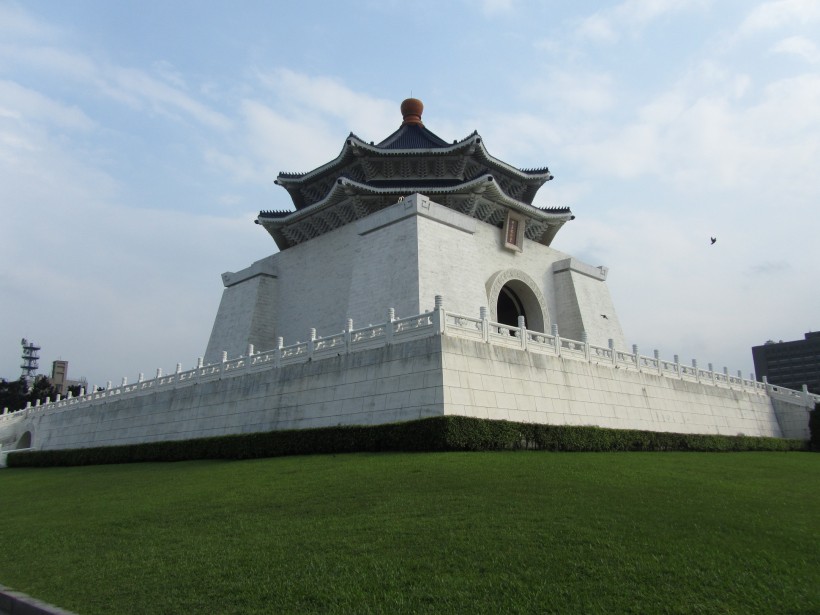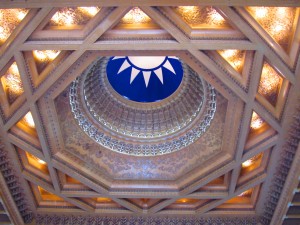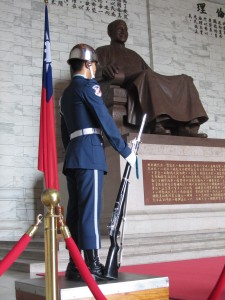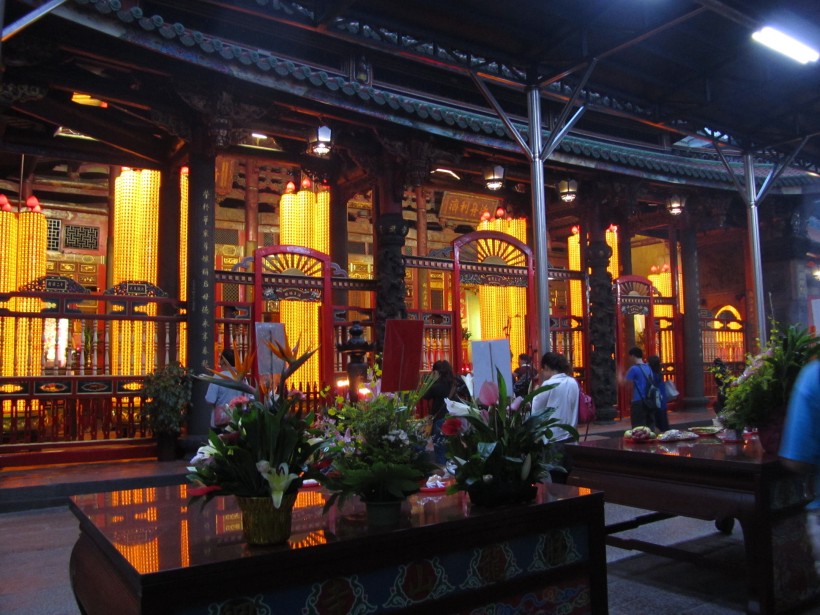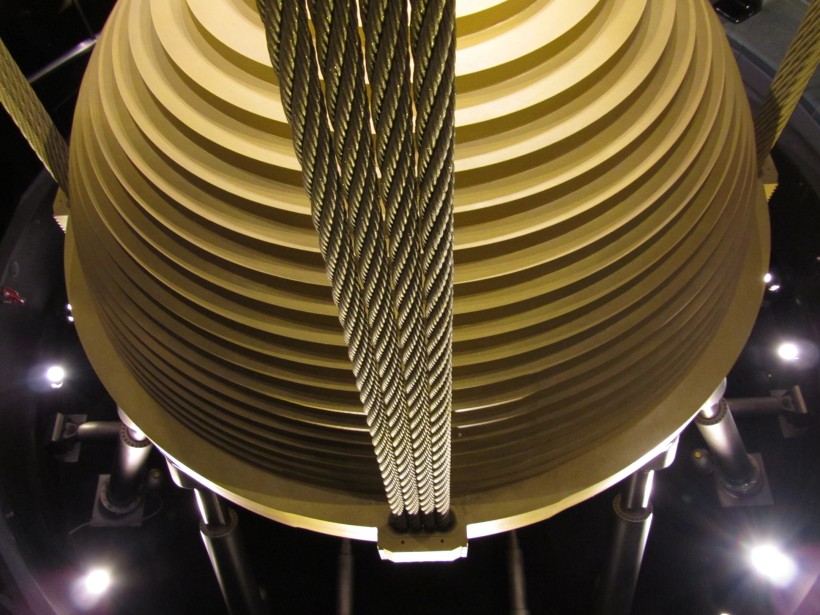I took the bullet train to Taipei without any hassles. Once there, I decided to start the day off by visiting the Sun Yat-sen Memorial Hall. This hall commemorates Dr. Sun Yat-Sen (1866-1925), who was a pro-democratic revolutionary instrumental in overthrowing the Qing Dynasty. He is revered in both Taiwan and China the way Americans revere Thomas Jefferson. In Taiwan he is known as “Father of the Nation.”
According to Wikipedia, in 2004 the Taiwan Ministry of Education proposed that he was not, in fact, the founder of Taiwan as an independent state (the legal and political issues on whether Taiwan is its own nation are a bit complicated), but instead a foreigner from China. It actually is factually true that he was born and raised in Mainland China, but that’s not actually all that important. The people who made the proposal were attacked with eggs and one 70-year-old veteran killed himself at the memorial in protest. No further proposals of the sort have been made.
Inside the Memorial, the first floor has a central hall where two honor guards watch over Dr. Sun Yat-sen’s statue. They do a changing of the guard every hour. It’s pretty interesting, but you have to get there early if you want a good spot because all the Chinese tour groups time it so that they arrive in the main hall about ten minutes before the guards change. I just happened to arrive exactly on time to watch them, which was pretty neat.
In addition to the central hall, there are exhibits on Dr. Sun Yat-sen’s life. It was pretty fascinating, although I did wish I knew more of China and Taiwan’s history in the 1900’s. The grounds outside are nice. There’s a little walkway around a pond, as well as a small garden. You can also see the Taipei 101 building.
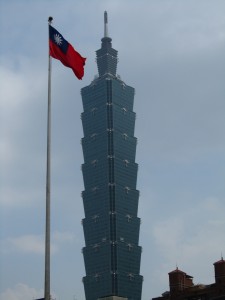 After that, it was off to the Chiang Kai-shek Memorial Hall. He was a successor to Dr. Sun Yat-sen and has a very long and kind of complicated political history that I don’t really know much about. I think the general gist of things was that he was a leader of the Nationalists, was very important during WW2, and after his party eventually lost to Mao’s Communist Party (largely due to corruption, if I understand correctly), he moved to Taiwan and became a well-loved President.
After that, it was off to the Chiang Kai-shek Memorial Hall. He was a successor to Dr. Sun Yat-sen and has a very long and kind of complicated political history that I don’t really know much about. I think the general gist of things was that he was a leader of the Nationalists, was very important during WW2, and after his party eventually lost to Mao’s Communist Party (largely due to corruption, if I understand correctly), he moved to Taiwan and became a well-loved President.
When you go up the stairs into the building, you arrive in the main hall with a statue of Chiang Kai-shek and an honor guard. Again, you can watch the changing of the guard on the hour. Incredibly, I arrived just as they were performing here, too! Clearly I have a good sense of timing. The floors below it consist of an exhibition hall, where I saw some very pretty brush paintings, and an exhibit on the life and career of Chiang Kai-shek that was very interesting.
In the late afternoon I moved on to Longshan Temple. It was made for the worship of a mixture of Buddhist and Taoist deities. This place is pretty cool because it’s the oldest temple in Tapiei, but is still used for everyday worship by the locals. There are intricate carvings everywhere, and the place is brightly painted.
The procedure for praying is pretty different than in Japan. Because a bunch of locals and tourists were there, it was pretty easy to observe them. When you enter the temple, you buy a pack of about seven incense sticks and light them with some candles. Then you slowly make your way to about seven different alters, each for a different deity. When you arrive at each one, you raise the incense to about eye-level and bow three times. You place one of the incense sticks into a very big burner, much like the ones I’ve seen in Japan -makes sense, considering Buddhism entered Japan through China- pray, and move on to the next one. The exit has various charms you can buy, but no explanations in English.
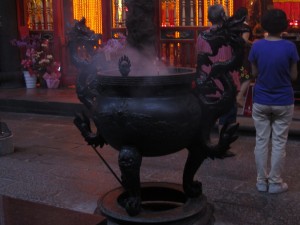 Once night had fallen it was time to go to the Taipei 101 Building, which was the tallest building in the world from 2004 to 2010 if I have my dates right. It still holds the fastest elevator in the world. You can definitely feel the speed in your stomach! I’m glad that I was in Taiwan during the low season, because even then there was a line to buy the tickets, which were $500NT (or you could buy a fast pass for $1000NT that would allow you to skip all the lines), and then a line to get on the elevator, and also a line to go back down the elevator. It must be a nightmare during the high season.
Once night had fallen it was time to go to the Taipei 101 Building, which was the tallest building in the world from 2004 to 2010 if I have my dates right. It still holds the fastest elevator in the world. You can definitely feel the speed in your stomach! I’m glad that I was in Taiwan during the low season, because even then there was a line to buy the tickets, which were $500NT (or you could buy a fast pass for $1000NT that would allow you to skip all the lines), and then a line to get on the elevator, and also a line to go back down the elevator. It must be a nightmare during the high season.
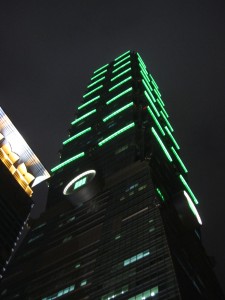 The night view of the city was beautiful! I really enjoyed seeing Taipei from up so high. Actually, I really love any high view of a city at night; I’ve been up several similar buildings but I never really get tired of it. The outside observation deck was fun, too.
The night view of the city was beautiful! I really enjoyed seeing Taipei from up so high. Actually, I really love any high view of a city at night; I’ve been up several similar buildings but I never really get tired of it. The outside observation deck was fun, too.
The Taipei 101 building has a floor that lets you see the wind damper. It’s basically this 660 ton ball that is suspended by wires and held up by some kind of hydraulic things. It reduces the amount of swaying that the building does by a significant percentage. Naturally, the people at the building have turned it into the Taipei 101 mascot by creating a bunch of “damper babies” that come in various colors and meanings. I have to say, I didn’t find them all that cute. The damper itself was pretty interesting, though. There was a video showing it swaying during a typhoon on one side of the observation floor, and a video explaining the damper on the other.
Unfortunately, they make you go through a jewelry shop on your way to the down elevators. It was very tempting, but I managed to refrain from getting myself any necklaces. But one cool thing was that the store had these insanely expensive coral gemstone carvings, which were really impressive. I can’t even imagine being able to create something so intricate!
One problem when buying Jade is that there is a huge counterfeit market for it. The saleswoman I spoke to mentioned that one way to tell genuine jade from Taiwan is to look for little dark green flecks. Fake jade won’t have those. Telling other types of jade apart is more complicated. Even department stores may carry fake jade. Real jade is heavier than it looks. It is also cool to the touch and slow to heat up. Shining a light through it should intensify the differences between the various shades of color within the piece. The colors in counterfeit jade will become more diffuse under light. It may also have air bubbles in it. High-end jade is really expensive, and should come with a certificate of authenticity.
Coral gemstone also suffers from a counterfeiting problem. The salesman I spoke to told me that real coral gemstone should show white where he piece was cut. So the underside of a pendant should have at least hints of white to it. No idea if that’s true or not, but that’s what he told me.
The next day I was able to see some really incredible jade at the National Palace Museum. The museum looks like a palace from the outside, but it wasn’t actually built until 1965 or so. When the Japanese invaded China during WW2, a very large amount of important historical artifacts were sent out to the countryside to escape the bombings and destruction. The Chinese Civil War had been put on hold by the invasion but resumed after Japan surrendered. About 600,000 artifacts were shipped to Taiwan for safekeeping. Of course they can’t display all those at once, so only a fraction are on exhibition.
Because it’s filled with so many important Chinese historical and cultural artifacts, the museum is very popular with large tour groups from the mainland. It can be very frustrating at times trying to see everything. At one point a tour guide actually had the audacity to grab my arm to try to move me out of his way. A museum worker was standing nearby, saw me lingering even though the room was really crowded with tour groups, and asked me if I wanted to see the next artifact.
I told him yes, I wanted to see everything, but I didn’t want to hurry about it. I also asked him to tell the tour guide not to touch me again. He gave the tour guide a “what did you just do?” look, and the tour guide backed off. It made me so angry. I paid for my ticket, just like everyone else, and I had every right to see things at my own pace. Anyone in a hurry was welcome to go around me. If I could do it again, I would get there as soon as the museum opened and go directly to the third floor so I could see the most popular exhibits and work my way down. As it was, I ended up skipping most of the porcelain entirely. The tour groups seemed to only see the most popular exhibits, leaving the other ones uncrowded.
I really love museums and history, so aside from the crowds in parts of the building it was really cool. China is old. Really, really old. There were jade carvings from 3,000 B.C.E. and bronze castings older than that. It was kind of mind-boggling. Pieces have had a distinctly Chinese artistic style since 4,000 B.C.E. or so. One of the things I love about East Asia is how I get to experience a different perspective on things like culture and time.
My favorite exhibits were probably the jade, ivory, and brush painting exhibits. The porcelain didn’t interest me so much, and I kind of hurried my way through the bronze. It was really interesting to see how the function, subject, and artistic style of the jade pieces changed over time. The oldest ones were mostly of animals, due to the fact that the society believed in animism at the time. As society progressed, the artists moved on to different subjects and the pieces became more and more intricate.
The ivory was just incredible. The wonderful beauty and level of detail in those works was staggering. In addition to things like statues and lattice lunch boxes, there were these awesome miniatures that were very impressive. I was also able to see some really gorgeous brush paintings. The museum was well worth the visit.
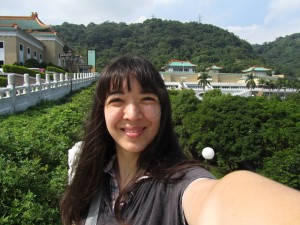 The National Palace Museum was actually the only place I saw that day. After I finished up there, I just went back to my hotel to rest up. It ended up being really relaxing. I rested up, then took the train to Hualien.
The National Palace Museum was actually the only place I saw that day. After I finished up there, I just went back to my hotel to rest up. It ended up being really relaxing. I rested up, then took the train to Hualien.


